Cape Wrath: Difference between revisions
No edit summary |
|||
| Line 1: | Line 1: | ||
[[File:CapeWrathFromSeawardByColinWheatleyFeb2007.jpg|right|thumb|350px|Cape Wrath from the sea]] | |||
{{county|Sutherland}} | |||
'''Cape Wrath''' is a high headland in the parish of [[Durness]] in [[Sutherland]]. It is the most north-westerly point on the mainland of [[Great Britain]]. It is one of only two places in Great Britain that are prefixed with "Cape", the other being [[Cape Cornwall]] in [[Cornwall]]. | '''Cape Wrath''' is a high headland in the parish of [[Durness]] in [[Sutherland]]. It is the most north-westerly point on the mainland of [[Great Britain]]. It is one of only two places in Great Britain that are prefixed with "Cape", the other being [[Cape Cornwall]] in [[Cornwall]]. | ||
The cape is almost separated from the mainland by the [[Kyle of Durness]], which severs any road connection, for the Kyle must be crossed by ferry. The cape consists of | The cape is almost separated from the mainland by the [[Kyle of Durness]], which severs any road connection, for the Kyle must be crossed by ferry. The cape consists of 107 square miles of moorland wilderness known as the Parph. | ||
The first road in the district was built in 1828 by the lighthouse commission across the Parph. This road is only accessible by the passenger ferry that crosses the Kyle of Durness. | The first road in the district was built in 1828 by the lighthouse commission across the Parph. This road is only accessible by the passenger ferry that crosses the Kyle of Durness. | ||
| Line 105: | Line 101: | ||
==Outside links== | ==Outside links== | ||
*Location map: {{wmap|58.6248|-5.0015|zoom=14}} | |||
*[http://www.capewrath.org.uk Cape Wrath tourism] | *[http://www.capewrath.org.uk Cape Wrath tourism] | ||
*[http://www.capewrathferry.co.uk Cape Wrath ferry] | *[http://www.capewrathferry.co.uk Cape Wrath ferry] | ||
Latest revision as of 09:36, 20 January 2018
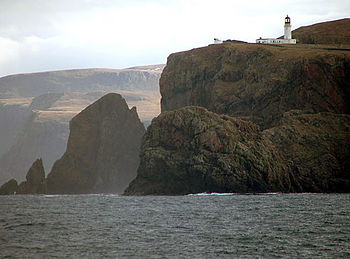
Cape Wrath is a high headland in the parish of Durness in Sutherland. It is the most north-westerly point on the mainland of Great Britain. It is one of only two places in Great Britain that are prefixed with "Cape", the other being Cape Cornwall in Cornwall.
The cape is almost separated from the mainland by the Kyle of Durness, which severs any road connection, for the Kyle must be crossed by ferry. The cape consists of 107 square miles of moorland wilderness known as the Parph.
The first road in the district was built in 1828 by the lighthouse commission across the Parph. This road is only accessible by the passenger ferry that crosses the Kyle of Durness.
Much of the cape is owned by the Ministry of Defence and is used as a military training area, including use as live firing range for heavy munitions. Areas of the cape are also designated as a Site of Special Scientific Interest, a Special Protection Area, a Special Area of Conservation and a Special Landscape Area.
Name
In the local Gaelic, Cape Wrath is known as Am Parbh, and it is known in Lewis Gaelic as An Carbh.
The name "Cape Wrath" is derived from Old Norse hvarf, meaning "turning point", as the land turns the corner here from the north coast to the west.
Geography
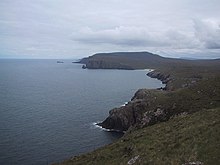
Cape Wrath is the most North-Westerly point on the British mainland. It has no villages and Durness 10 miles is the closest village.
The sea cliffs around the cape are made up of Torridonian sandstone and Lewisian gneiss.[1][2] These rise up to 921.9 feet above sea level and include the highest sea cliffs on the British mainland at Clò Mòr around 4 miles to the east of the headland.[3][4] Sea stacks, such as Stac an Dùnain at the cape itself and Stac Clò Kearvaig to the east, rise out of the sea off the coastline, with Duslic, a reef, half a mile north of the cape.
Crofting townships of two or three houses with associated enclosures existed at Daill, Achiemore, Kearvaig and Inshore into the mid-20th century.[5][6][7][8]
The land originally formed part of the Sutherland estates owned by the Duke of Sutherland.[5][8] Much of it was sold to the armed forces in the 1930s for use as a military training area.
The Cape's exposed northerly position can give rise to some exceptionally low winter sunshine levels: in January 1983 it recorded just 38 minutes of sunshine.[9] This exposed position, however, also means severe frost rare compared to inland locations such as Altnaharra or Kinbrace. The record low of -6.9°C is comparable to those recorded on Shetland, the Hebrides and the Isles of Scilly. A slight fohn effect can also occur with the right angle of southerly winds, exemplified by the record December high of 17.7°C.
Strong winds can be a feature of weather conditions at the cape, with gusts of 140 mph recorded.
History
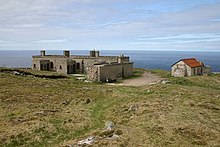
Cape Wrath was once the home of a series of small crofting communities, although by 1845 the only families remaining on the Parph were those of shepherds.[5] In the 1930s it supported a population of 30 to 40 people, including a small side school at Achiemore which had up to ten pupils in the 1930s but closed in 1947.[10][11][12][13] Building remains at locations such as Kearvaig have been dated to the 18th century.[14]
The cape has few archaeological remains which can be dated to earlier than this, although a promontory fort at Eilean nan Coarach to the east of the headland may date to the late prehistoric age.[14][15]
Much of the area has been used for sheep gazing, a use which continues today, and shielings, shelters built for shepherds, can be found across the cape.[14] The area declined in population in the mid 20th century and is now almost entirely unpopulated, although military and tourism use continues. The lighthouse was built in 1828 and the access road from the Kyle of Durness dates from the same period.
On 27 September 1915, while sailing for Scapa Flow, HMS Caribbean (known as Dunottar Castle before being requisitioned for wartime service) foundered off Cape Wrath in bad weather. A tow by HMS Birkenhead was unsuccessful, and 15 died.[16] An inquiry later blamed the ship's carpenter for being insufficiently familiar with the ship and for failing to shut all the scuttles, for like most of the crew, he had joined the ship just 10 days earlier.[17] The wreck was found in 2004, 35 miles off Cape Wrath, in 52.5 fathoms (96.0 m) of water and undisturbed except for fishing nets.[17][18]
Natural environment
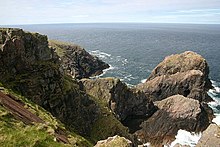
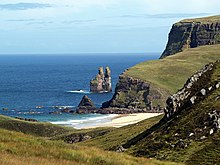
Because its landscape is largely untouched by humans, Cape Wrath has a wide diversity of wildlife, including red deer, fulmar, hooded crow, rock pipit, golden eagle, cormorant and gannet.[19] An area of 2,518 acres is designated as a Special Protection Area (SPA) and a Site of Special Scientific Interest (SSSI).[1] The cliffs around the cape are an internationally important nesting site for over 50000 sea birds, including colonies of Puffin Fratercula arctica, Razorbill Alca torda, Guillemot Uria aalge, Kittiwake Rissa tridactyla and Fulmar Fulmarus glacialis.[1][2] The SPA area extends 1.2 miles out to sea and includes the sea bed and marine environment which is a source of food for the bird population of the area.[1][2]
Numbers of seabirds in the area saw significant declines in the early 21st century with Puffin numbers falling by 50%.[20] An area of 2,509 acres is also designated as a Special Area of Conservation.[21] Marine species present in the area include harbour porpoise, common seal and bottle-nosed dolphin as well as species such as sea squirts and sponges.[3]
The cliff-top vegetation at sites such as Clò Mòr includes common scurvygrass Cochlearia officinalis and a wide range of habitats are present. These include cliff-top sand dunes at the cape itself as well as montane habitats found at sea level.[19][21]
An area of 47 square miles around the coastline is designated as a Special Landscape Area.[4] This area extends from Oldshoremore in the south-west to Durness in the east and includes the entire coastline of the cape area.[4] Just offshore is Stac Clò Kearvaig, also known as "The Cathedral" due to the appearance of two spires and a natural window created by erosion. To the east lies Garvie Island, one of the main targets for live firing by the military.
Inland the landscape is primarily covered in peat and is often boggy with difficult terrain and a number of lochans, the largest of which, Loch Airigh na Beinne, is around 148.3 acres in area.[19] The area has been described as one of the few coastal wildernesses in Britain.[4] Plant species include Heather Calluna vulgaris, Juniper Juniperus communis and ferns.[1]
The cape is part of the "North West Highlands Geopark", a 772.2 square miles area with UNESCO geopark status.[22]
Military use
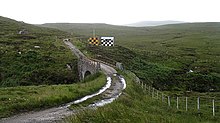
The Ministry of Defence owns an area of the cape of 23 square miles known as the Cape Wrath Training Centre.[23] The cape was used for training exercises from the early years of the 20th century,[24] with the first bye-laws established in 1933 to allow use of the area as a firing range.[23][24] The area was used originally as a naval gunnery range and was bought by the MoD in 1999.[23][24] Since 2005 the area has been used as a multi-services training area and is one of the sites used in the Joint Warrior exercises, Europe's largest military exercise, and by other NATO operations.[23][25][26] Training usually takes place in the spring and autumn, although times can be unpredictable. The range is usually open for public access during the summer period and there is rarely firing on Sundays.[27]
The MoD owns a number of the surviving buildings in the area and operates observation posts and sentry posts during training.[23] It is used for naval gunfire practice and for army artillery and mortar range firing.[27] Disused military vehicles are often used as targets.[25] The RAF uses Garvie Island as a target for a range of training operations.[27] It is the only place in the Northern Hemisphere where NATO forces combine land, air and sea capabilities in assault mode for training maneouvres, deploying ordnance up to 1000 lb bombs.[28][29] Firing on the range is controlled from Faraid Head close to Balnakeil.[28]
In 2008 a heath fire was caused on the range during a period of live firing. An area of around 339 acres was affected. Scottish Natural Heritage estimated that the area would take 10 years to return to its normal environmental conditions.[25][30][31]
Concern has also been raised of the effects of military exercises on nesting birds[25], on sheep during lambing season and the effects of noise on local residents.[30][32][33] A shell fired during exercises caused concern in 2002 when it landed 8 miles off target near the mouth of Loch Eriboll and around a mile from houses.[32][34]
Cape Wrath Lighthouse
- Main article: Cape Wrath Lighthouse
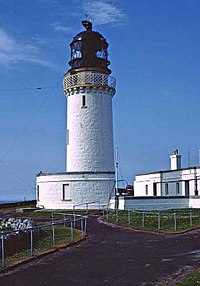
The lighthouse at the Cape was built in 1828 by Robert Stevenson and was manned until 1998, when it was converted to automatic operation by the Northern Lighthouse Board.[35] Overlooking the Cape are the ruins of the Lloyd's signal station, which was used to monitor shipping and was built at the same time as the lighthouse.[36]
The lighthouse is 66 feet tall, a white-washed tower built of granite with a single storey semi-circular base building.[37][38] The current light characteristic is four white flashes every 30 seconds (Fl(4).W.30s) and is visible for 22 nautical miles.[35] The light is 400 feet above sea level.
The light was originally a paraffin lamp with red and white reflectors. This was replaced by mercury vapour lamps in 1978 and in 1980 an electrical temporary power beam was installed with a gearless pedestal and array system later in the same year. The optics are a first order Fresnel lens and the light has a power rating of 200,000 candela.[39] The fog-horn at the site was discontinued in 2001.[39]
A number of lighthouse keepers cottages and store buildings are located near to the lighthouse, with the complex surrounded by a perimeter wall.[37][38][40] The lighthouse and its associated buildings are designated as a Grade A listed building.[37][38] Much of the material for the lighthouse was quarried locally during construction, particularly from Clais Charnach.[39] A coastguard station was built next to the derelict signalling station during the Second World War.[36]
Due to its height the light was often obscured by low cloud or fog and in the early 20th century plans were drawn up to build an additional low light. This involved the construction of tunnels into the headland, bridges and building on the very tip of the rocks below the headland. Plans were drawn up by David Alan Stevenson, Robert's grandson and work began in 1913 but was suspended at the start of the First World War and never restarted.[39]
A slipway was built in 1827, before construction of the lighthouse, at Clais Charnach, a steep sided gully around 1.7 miles southeast of the lighthouse.[41] This was used during the building of the lighthouse to supply materials along a rough road and was the main landing point for supplies and stores during the manned operation of the lighthouse, although from 1977 onwards helicopters were also used for resupply.[39] Store buildings were constructed at the same time, one of which is still in use by the Ministry of Defence. The slipway was extended and rebuilt in around 1863 and remains in use as a landing site for the lighthouse.[41] The access road from the Kyle of Durness was built to support the lighthouse in 1828.[42]
Tourism
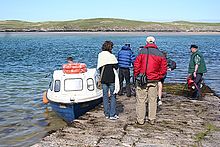
The cape is visited by at least 2000 and as many as 5000 tourists each year, attracted by the wilderness nature of the area, the wildlife and natural environment and to visit the lighthouse.[19][43] The tourist industry is estimated to be worth at least £400000 to the economy of the local area around Durness.[43]
The cape is the northern trail head of the Cape Wrath Trail, a 200-mile walking trail considered the toughest in Britain, through isolated country from Fort William, and the Gore-tex Scottish National Trail, a 460 mile route from Kirk Yetholm in Roxburghshire.
Cape Wrath is also the turning point for the Cape Wrath Marathon, a race made particularly strenuous by the continuously undulating terrain. It runs for 11 miles out to the lighthouse and the same distance back to the ferry dock on the Cape side. The final 4-mile leg of the race is run from the mainland side from the ferry dock and finishes at Durness Community Centre. The marathon is held each year as the final event of a week of races called the Cape Wrath Challenge.[44]
The sole inhabitants of the cape are now John and Kay Ure who leased the main building in 2009. They converted it into a three-bedroomed home, and opened what is claimed to be Britain's most remote café, the Ozone Café, in 2009.[19] The café was opened by the Princess Royal, and seats eight people.[45]
Transport
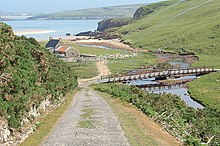
From the south, the only route to the Cape is on foot from Sandwood Bay and Kinlochbervie. Access is restricted at times by military operations on the cape.
A rough road of around 11 miles links the lighthouse with the Kyle of Durness which is crossed by a passenger ferry service operating between May and September. The road was built as part of the lighthouse construction in 1828 and, in places, uses a series of rock causeways to cross peat bogs and revetments to maintain a route along steep slopes. Materials for the road were quarried locally and there are a number of quarrying sites along it.[42] The road is marked with milestones and crosses the Allt na Guaille and Kearvaig River on contemporary arched bridges.[42][46][47] The original slipway on the Kyle of Durness was built north of Daill with an associated storehouse similar to that at Clais Charnach.[48] This was linked by a rough track with the road being extended south the slipway at Ferry House during the 1830s.[48][49]
The road, the U70, passes the hamlet of Achiemore where a Ministry of Defence check-point blocks access to the cape during live firing exercises.[11][19] It passes the farmsteads of Daill and Inshore, where the MoD uses the remaining house,[8] before a track to the right links the road to the old hamlet of Kearvaig, where there is a beach and Kearvaig House which the Mountain Bothies Association have converted into a Bothy.[5][50] A minibus service operates along the road during the summer period linking the ferry slipway with the lighthouse. The road, ferry and minibus service are suspended during military training operations on the cape.[28]
See also
Outside links
- Location map: 58°37’29"N, 5°0’5"W
- Cape Wrath tourism
- Cape Wrath ferry
- Cape Wrath Training Area, Military of Defence information, including access information and contact telephone numbers
- North West Highlands Geopark
References
- ↑ 1.0 1.1 1.2 1.3 1.4 Cape Wrath, SPA designation, Joint Nature Conservation Committee. Retrieved 2013-02-06.
- ↑ 2.0 2.1 2.2 Cape Wrath, Citation for Special Protection Area, Scottish Natural Heritage, September 2009. Retrieved 2013-02-06.
- ↑ 3.0 3.1 Coasts and seas of the United Kingdom, Region 3 North-east Scotland: Cape Wrath to St. Cyrus, Joint Nature Conservation Committee, 2006. Retrieved 2013-02-06.
- ↑ 4.0 4.1 4.2 4.3 Assessment of Highland Special Landscape Areas, The Highland Council, June 2011. Retrieved 2013-02-05.
- ↑ 5.0 5.1 5.2 5.3 Kearvaig, Royal Commission on the ancient and historical monuments of Scotland. Retrieved 2013-02-08.
- ↑ Daill, Royal Commission on the ancient and historical monuments of Scotland. Retrieved 2013-02-08.
- ↑ Achiemore, Royal Commission on the ancient and historical monuments of Scotland. Retrieved 2013-02-08.
- ↑ 8.0 8.1 8.2 Inshore, Royal Commission on the ancient and historical monuments of Scotland. Retrieved 2013-02-08.
- ↑ "Gazetteer: Climate". loveofscotland.com. http://www.loveofscotland.com/gazet.html. Retrieved 3 February 2013.
- ↑ Cafe at the end of the universe ... where a cup of tea is guaranteed, The Herald, 2009-06-09. Retrieved 2013-02-08.
- ↑ 11.0 11.1 Achiemore, Royal Commission on the ancient and historical monuments of Scotland. Retrieved 2013-02-08.
- ↑ Durness Schools, Education in Sutherland, 2009-03-29. Retrieved 2013-02-09.
- ↑ Uney.G (2009) Backpacker's Britain: Northern Scotland: thirty two and three day treks, p.86. Cicerone Press Limited. ISBN:978-1-85284-458-5 (online). Retrieved 2011-01-28.
- ↑ 14.0 14.1 14.2 'Archaeology on the edge - Cape Wrath', Sanctuary vol 38, pp.50-51, 2009, Ministry of Defence (available online). Retrieved 2013-02-06.
- ↑ Eilean nan Caorach, Royal Commission on the ancient and historical monuments of Scotland. Retrieved 2013-02-08.
- ↑ 17.0 17.1 Divers explore WW1 wreck of HMS Caribbean, Divernet news, 2004-05-31. Retrieved 2013-02-06.
- ↑ Robinson, Andrew (16 June 2004). "Yorkshire diver first to see wreck for nearly 90 years". Yorkshire Post. http://www.yorkshirepost.co.uk/news/around-yorkshire/local-stories/yorkshire-diver-first-to-see-wreck-for-nearly-90-years-1-2545421. Retrieved 2007-08-06.
- ↑ 19.0 19.1 19.2 19.3 19.4 19.5 Snap! Cape Wrath to grace playing cards, The Scotsman, 2010-04-08. Retrieved 2013-02-06.
- ↑ 'Ringing in the century', Sanctuary no.38, 2009, pp.20-23, Ministry of Defence (available online). Retrieved 2013-02-06.
- ↑ 21.0 21.1 Cape Wrath, Site details, Joint Nature Conservation Committee. Retrieved 2013-02-06.
- ↑ Geopark
- ↑ 23.0 23.1 23.2 23.3 23.4 Cape Wrath Range, Royal Commission on the Ancient and Historical Monuments of Scotland. Retrieved 2013-02-05.
- ↑ 24.0 24.1 24.2 Public Information Leaflet, Defence Training Estate Scotland. Retrieved 2013-02-06.
- ↑ 25.0 25.1 25.2 25.3 'Don't bomb' idea for Cape Wrath firing range, BBC news website, 2010-01-10. Retrieved 2013-02-05.
- ↑ NW will play part in largest military exercise in Europe, The Northern Times, 2009-09-21. Retrieved 2013-02-09.
- ↑ 27.0 27.1 27.2 Military activities undertaken at Cape Wrath, Royal Navy. Retrieved 2013-02-05.
- ↑ 28.0 28.1 28.2 Cape Wrath Training Area, Ministry of Defence. Retrieved 2013-02-06.
- ↑ Cape Wrath Training Area, Public access to military areas, Ministry of Defence, 2012-12-12. Retrieved 2013-02-06.
- ↑ 30.0 30.1 MoD accused of 'wildlife crime', BBC news website, 2008-05-08. Retrieved 2013-02-05.
- ↑ New details emerge on cape fire, BBC news website, 2008-06-06. Retrieved 2013-02-05.
- ↑ 32.0 32.1 Concern over live shelling, BBC news website, 2003-02-24. Retrieved 2013-02-05.
- ↑ Protest over Nato exercise, The Northern Times, 2011-11-11. Retrieved 2013-02-08.
- ↑ Inquiry into shell incident, BBC news website, 2002-07-09. Retrieved 2013-02-05.
- ↑ 35.0 35.1 Northern Lighthouse Board
- ↑ 36.0 36.1 Cape Wrath, Dunan Mor, Signalling Station, Royal Commission on the Ancient and Historical Monuments of Scotland. Retrieved 2013-02-05.
- ↑ 37.0 37.1 37.2 Cape Wrath Lighthouse and Keeper's cottages, Listing information, Historic Scotland. Retrieved 2013-02-08.
- ↑ 38.0 38.1 38.2 Cape Wrath Lighthouse and Keeper's cottages, Historic Scotland. Retrieved 2013-02-08.
- ↑ 39.0 39.1 39.2 39.3 39.4 Cape Wrath Lighthouse, Engineering timelines. Retrieved 2013-02-08.
- ↑ Cape Wrath Lighthouse, Royal Commission on the Ancient and Historical Monuments of Scotland. Retrieved 2013-02-05.
- ↑ 41.0 41.1 Calis Charnach Slipway, Royal Commission on the Ancient and Historical Monuments of Scotland. Retrieved 2013-02-05.
- ↑ 42.0 42.1 42.2 Kyle of Durness to Cape Wrath lighthouse, Royal Commission on the Ancient and Historical Monuments of Scotland. Retrieved 2013-02-05.
- ↑ 43.0 43.1 Huge cost to economy if access to Cape Wrath is denied, The Northern Times, 2012-12-21. Retrieved 2013-02-08.
- ↑ Hundreds set to take on the Cape, The Northern Times, 2007-05-04. Retrieved 2013-02-08.
- ↑ Hardman, Robert (2009-06-20). "A cuppa at the end of the world". Daily Mail (London: Associated Newspapers Ltd): p. 42–43.
- ↑ Allt na Guaille, Royal Commission on the Ancient and Historical Monuments of Scotland. Retrieved 2013-02-05.
- ↑ Kearvaig River road bridge, Royal Commission on the Ancient and Historical Monuments of Scotland. Retrieved 2013-02-05.
- ↑ 48.0 48.1 Kyle of Durness storehouse to Cape Wrath lighthouse, Royal Commission on the ancient and historical monuments of Scotland. Retrieved 2013-02-08.
- ↑ Kyle of Durness, Royal Commission on the ancient and historical monuments of Scotland. Retrieved 2013-02-08.
- ↑ Margaret's story, The Guardian, 2002-12-18. Retrieved 2013-02-05.